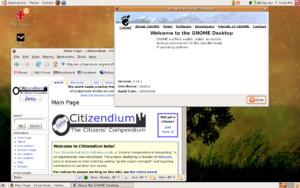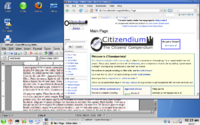Linux (operating system): Difference between revisions
imported>Pat Palmer No edit summary |
imported>Joshua David Williams (added See also link to Monolithic versus Microkernel) |
||
| Line 88: | Line 88: | ||
*[[Linux distribution|Linux distributions]] | *[[Linux distribution|Linux distributions]] | ||
*[[Linux history]] | *[[Linux history]] | ||
*[[Monolithic versus Microkernel]] | |||
==External Links== | ==External Links== | ||
Revision as of 10:32, 9 April 2007
| Linux |

|
| The GNOME desktop on Ubuntu Linux 6.10 |
| Website: http://www.linux.org |
| Developer: The Open Source community |
| OS family: Unix-like |
| Source model: Open source |
| Latest stable release:[1] |
| Supported platforms: x86, x86-64, ia64, DEC Alpha, Motorola 68k, SUN Sparc, ARM, PowerPC |
| Kernel type: Monolithic kernel |
| Default user interface (most distros): GUI |
| License: GNU General Public License |
| Working state: Current |

Linux is an operating system remarkable for the community-driven effort which led to its creation. It is also notable for running on the same Intel x86 hardware platform as the Windows and Mac operating system families, for being a very low-cost alternative to Windows, and for having a user experience that is nearly identical to the previously very popular Unix operating system. Its feature set is comparable to the commercial offerings from Microsoft and Apple.
Since its advent in the early 1990's, the success of Linux has been something of a disruptive force within the computer industry. Linux has subsequently become a poster boy of the open source movement, possibly portending a paradigm shift in traditional closed-door software development.
Linux is open source software, which means it is written and improved upon through a community effort, and it can be obtained and used for free by anyone. Furthermore, numerous companies are able to earn money by offering "supported distributions" of Linux which have certain guarantees in terms of reliability and expected bug fixes, so customers who pay for one of the "supported" versions of Linux (such as Red Hat, or others) can rest assured that someone will help them if a serious problem arises. These specially packaged versions of Linux are called Linux distributions.
The origins of Linux are remarkable. The first Linux kernel was written by an upstart college student from Norway in 1991 in defiance of a competing, commercial effort by a renowned professor of computer architecture. The ensuing debate about what is practical and implementable versus academic theory between Linux' original creator, Linus Torvalds, and Dr. Andrew S. Tanenbaum[2] of Vrije Universiteit, The Netherlands, has been retold repeatedly with amusement and amazement (please see the Monolithic versus Microkernel article for more information).
Although first developed for the the Intel i386 architecture, Linux has since been ported to numerous hardware platforms, including Intel i686, AMD64, SPARC, and Xbox systems. Although it has been very successful in a server environment, Linux has also attained status as a viable desktop platform.
Naming
The original name 'Linux' came from the author's name, Linus, along with the "x" in Unix, to show that it is Unix-like. Linus originally intended to call the project "Freax", for Free and Freak, with the "x" denoting that it is Unix-like, but after one of his colleagues named the system's FTP directory after him, the name stuck.[3]
GNU/Linux naming controversy
In 1984, The Free Software Foundation, founded by Richard M Stallman, made an attempt to create a free Unix-like operating system, which they called the GNU system.[4]
They began with the necessary tools for the system, such as a compiler, debugger, and a text editor. Their plan was to then create a kernel to place beneath the tools that they had created. Unfortunately, the foundation was very late in producing a stable release, and even to this day development of the HURD (the GNU kernel) continues without a stable first release.
It was during this time that Torvalds first introduced his kernel. Before Linux, hackers had no choice but to use non-free kernels, most notably Minix. While the GNU kernel began to look more and more like vaporware every day, the community received Linux with open arms and many began to contribute.
From gnu.org: "Variants of the GNU operating system, which use the kernel called Linux, are now widely used; though these systems are often referred to as “Linux”, they are more accurately called GNU/Linux systems."
The GNU Project members decided to call 'Linux' GNU/Linux, in order to attribute credit to those who worked hard at creating the tools that the Linux kernel runs. Torvalds, however, has made no effort to hide his thoughts towards this naming convention, saying that "calling Linux in general just 'GNU/Linux' I think is ridiculous."[5]
Pronunciation
Linux is pronounced like 'Minix' - that is, "'li' is pronounced with a short [ee] sound: compare prInt, mInImal etc.'nux' is also short, non-diphtong, like in pUt."[3]
Software
Aside from the GNU project's applications, Linux is capable of running many applications of all natures, from games and graphic editors to Integrated Development Environments and web servers. Among the most commonly used applications are The GIMP photo editing tool, which is commonly referred to as a free alternative to Photoshop, Firefox, a feature-complete, tabbed web browser, and OpenOffice, which is a free, full-featured alternative to the Microsoft Office suite. The GIMP, Firefox and OpenOffice are all cross-platform as well, meaning they run on Microsoft Windows and Mac OS X.
Unlike Microsoft Windows NT, Linux itself is not a graphical system. Instead, Linux relies on a graphical layer to output bitmap images. The most common application for this is called X.org, commonly referred to as just X. X.org is a very minimal program that purposely does as little as possible. Users do not normally see it, but the results of its work. X.org serves as a layer between the kernel and the desktop environment or window manager. Window managers, like Openbox or wmii, are only able to manage windows and desktops, while desktop environments, such as GNOME, KDE and Xfce, provide advanced graphical functionality, such as the ability to process text, organize photos or chat online.
References
- ↑ "Top 10 Distributions". Retrieved on 2007-04-09.
- ↑ Andrew S. Tanenbaum, Professor of Computer Science. Vrije Universiteit, Amsterdam, The Netherlands. Retrieved on 2007-04-06.
- ↑ 3.0 3.1 USENET post on Linux naming (Retreived 06 April 2007).
- ↑ About the GNU Project (Retreived 06 April 2007).
- ↑ The "GNU/Linux" and "Linux" Controversy (Retreived 06 April 2007).
